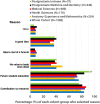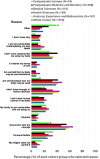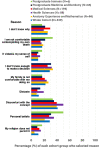Altruism in death: Attitudes to body and organ donation in Australian students
- PMID: 35344291
- PMCID: PMC10084255
- DOI: 10.1002/ase.2180
Altruism in death: Attitudes to body and organ donation in Australian students
Abstract
Health education, research, and training rely on the altruistic act of body donation for the supply of cadavers. Organ transplantation and research rely on donated organs. Supply of both is limited, with further restrictions in Australia due to requirements for a next-of-kin agreement to donation, irrespective of the deceased's pre-death consent. Research suggests health workers are less likely to support the donation of their own bodies and/or organs, despite recognizing the public good of donation, and that exposure to gross anatomy teaching may negatively affect support for donation. Attitudes to body and organ donation were examined in Australian students studying anatomy. Support for self-body donation (26.5%) was much lower than support for self-organ donation (82.5%). Ten percent of participants would not support the election of a family member or member of the public to donate their body, and just over 4% would not support the election of a family member to donate their organs, with one-to-two percent not supporting this election by a member of the public. Exposure to gross anatomy teaching was associated with an increased likelihood of consideration of issues about body and organ donation, whether for self, family, or the public, and registration as an organ donor. Exposure decreased participants' willingness to donate their own body, with those who practiced a religion least likely to support body donation. Gross anatomy courses provide an opportunity to inform future healthcare workers about altruistic donation, albeit with a recognition that religious or cultural beliefs may affect willingness to donate.
Keywords: anatomical dissection; attitudes; body donation; cadaver; gross anatomy education; organ donation; postgraduate education; undergraduate education.
© 2022 The Authors. Anatomical Sciences Education published by Wiley Periodicals LLC on behalf of American Association for Anatomy.
Conflict of interest statement
The authors declare no conflicts of interest, financial or otherwise.
Figures




Similar articles
-
Body donor programs in Australia and New Zealand: Current status and future opportunities.Anat Sci Educ. 2025 Mar;18(3):301-328. doi: 10.1002/ase.70004. Epub 2025 Feb 21. Anat Sci Educ. 2025. PMID: 39981657 Free PMC article. Review.
-
Attitudes of Slovenian students towards whole-body donation, organ donation, and the use of donated bodies in medical education.BMC Med Educ. 2024 Dec 26;24(1):1535. doi: 10.1186/s12909-024-06569-7. BMC Med Educ. 2024. PMID: 39725998 Free PMC article.
-
Willingness toward organ and body donation among anatomy professors and students in Mexico.Anat Sci Educ. 2017 Nov;10(6):589-597. doi: 10.1002/ase.1705. Epub 2017 Jun 2. Anat Sci Educ. 2017. PMID: 28575538
-
Cultural acceptability and personal willingness of Iranian students toward cadaveric donation.Anat Sci Educ. 2017 Mar;10(2):120-126. doi: 10.1002/ase.1634. Epub 2016 Aug 12. Anat Sci Educ. 2017. PMID: 27517382
-
Do religious and cultural considerations militate against body donation? An overview and a Christian perspective.Anat Sci Educ. 2024 Nov;17(8):1586-1595. doi: 10.1002/ase.2425. Epub 2024 Apr 18. Anat Sci Educ. 2024. PMID: 38634610 Review.
Cited by
-
Barriers in Body Donations for Anatomy Teaching: Lessons Learned From Students and Donors.Cureus. 2024 Oct 16;16(10):e71635. doi: 10.7759/cureus.71635. eCollection 2024 Oct. Cureus. 2024. PMID: 39552986 Free PMC article.
-
The acceptances and associated influences of body donation in Mainland China: a national cross-sectional study.Sci Rep. 2025 Apr 22;15(1):13920. doi: 10.1038/s41598-025-98401-5. Sci Rep. 2025. PMID: 40263594 Free PMC article.
-
Body donor programs in Australia and New Zealand: Current status and future opportunities.Anat Sci Educ. 2025 Mar;18(3):301-328. doi: 10.1002/ase.70004. Epub 2025 Feb 21. Anat Sci Educ. 2025. PMID: 39981657 Free PMC article. Review.
-
Challenges of access to cadavers in low- and middle-income countries (LMIC) for undergraduate medical teaching: a review and potential solutions in the form of 3D printed replicas.3D Print Med. 2025 Jun 14;11(1):28. doi: 10.1186/s41205-025-00277-8. 3D Print Med. 2025. PMID: 40515873 Free PMC article.
-
Attitudes of Slovenian students towards whole-body donation, organ donation, and the use of donated bodies in medical education.BMC Med Educ. 2024 Dec 26;24(1):1535. doi: 10.1186/s12909-024-06569-7. BMC Med Educ. 2024. PMID: 39725998 Free PMC article.
References
-
- Abbasi AJ, Nikzad H, Taherian A, Atlasi MA, Naderian H, Mousavi G, Kashani MM, Omidi A. 2017. Cultural acceptability and personal willingness of Iranian students toward cadaveric donation. Anat Sci Educ 10:120–126. - PubMed
-
- Alamneh YM. 2021. Knowledge and attitude towards ethical cadaver dissection among medical and health sciences students, 1997‐2020: A systematic review and meta‐analysis. Trans Res Anat 25:1001–1049.
-
- Alexander M, Marten M, Stewart E, Serafin S, Štrkalj G. 2014. Attitudes of Australian chiropractic students toward whole body donation: A cross‐sectional study. Anat Sci Educ 7:117–123. - PubMed
-
- Allison S, Notebaert A, Perkins E, Conway M, Dehon E. 2021. Fear of death and examination performance in a medical gross anatomy course with cadaveric dissection. Anat Sci Educ 14:764–773. - PubMed
-
- Anyanwu EG, Obikili E, Agu AU. 2014. The dissection room experience: A factor in the choice of organ and whole body donation – A Nigerian survey. Anat Sci Educ 7:56–63. - PubMed
MeSH terms
Grants and funding
LinkOut - more resources
Full Text Sources
Medical

